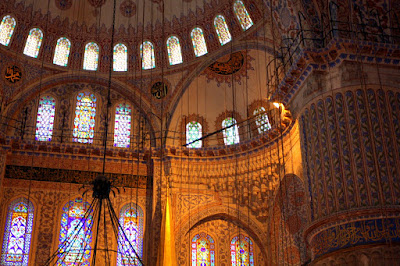


Apart from brief intervals,
Neglected thereafter,

During the bloody uprising of 532 that broke out at a chariot race in the Hippodrome, ten thousands of the inhabitants of the city were killed and numerous building destroyed. The Hagia Sophia church was among the structures burnt during this so-called "Nika" revolt which was directed against Emperor Justinian. When Justinian finally suppressed the revolt, he decided to build a house of worship "the like of which has not been seen since Adam, nor will it be seen in the future." Construction started in 532 over the remains of the previous basilica and it was completed in five years. In the year 537, elaborate ceremonies were organized for the dedication of this largest
Marbles and columns taken from the remains of earlier eras from almost all parts of the empire were used for building material. Although Hagia Sophia is a 6th century Byzantine work, it is an "experiment" in the Roman architectural tradition that has neither a predecessor nor a duplicate. The contrast between the interior and the exterior and the large dome are legacies of
The basilica developed into a large religious center with tall buildings surrounding it. The scene was now set for the clashes between the Byzantine emperors and the Eastern Church that would last for centuries.
Vast sums were spent in all ages for the upkeep of Hagia Sophia. The immediate restorations undertaken after the Turkish conquest in 1453 to convert it into a mosque saved this beautiful building. Among the major restorations at later times were the buttresses built by Turkish architect Sinan in the 16th century, the restoration by the Fossafi brothers in mid-19th century, and the repairs including the fortification of the dome with iron bands after 1930. Existing modern portable metal scaffolding will make future restoration work easier.
After serving two different religions with the same god, 916 years as a church and 477 years as a mosque, Hagia Sophia was converted into a museum on Ataturk's orders. Between 1930 and 1935 the whitewash on the walls was cleaned to reveal mosaics, which are among the most important examples of Byzantine art.



The design of the Sultan Ahmed Mosque is the culmination of two centuries of both Ottoman mosque and Byzantine church development. It incorporates some Byzantine elements of the neighboring Hagia Sophia with traditional Islamic architecture and is considered to be the last great mosque of the classical period.
At its lower levels and at every pier, the interior of the mosque is lined with more than 20,000 handmade ceramic tiles, made at Iznik (the ancient
The most important element in the interior of the mosque is the mihrab, which is made of finely carved and sculptured marble, with a stalactite niche and a double inscriptive panel above it. The adjacent walls are sheathed in ceramic tiles. But the many windows around it make it look less spectacular. To the right of the mihrab is the richly decorated minber, or pulpit, where the Imam stands when he is delivering his sermon at the time of noon prayer on Fridays or on holy days.
Obelisk of Theodosius at the Hippodrome


The hieroglyphic inscription on the Obelisk describes the victory of the pharaoh and a sacrifice to the god of the sun Amon-Ra in which the pharaoh kneels at the foot of the god.








No comments:
Post a Comment